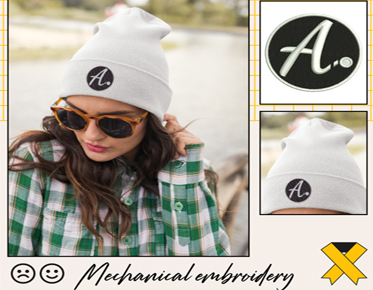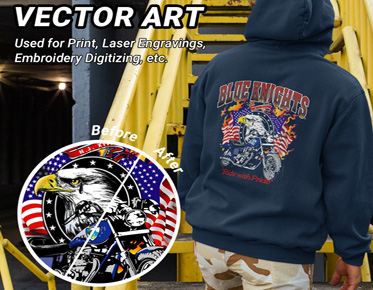Vector Art Design for Apparel: Fashioning Wearable Art
In the realm of fashion, apparel design has evolved beyond mere functionality to become a canvas for artistic expression. Vector art design plays a crucial role in this evolution, offering designers the tools and techniques to create intricate and captivating designs for wearable art. In this article, we explore the world of vector art design for apparel, from its definition and benefits to its application and challenges in the fashion industry.
Definition
and Characteristics
Vector art is a digital graphic format composed of scalable, mathematically-defined shapes and lines. Unlike raster images, which are composed of pixels, vector graphics can be scaled infinitely without losing quality, making them ideal for apparel design. Vector art is characterized by its crisp lines, smooth curves, and ability to maintain clarity and detail at any size.
Benefits
of Vector Art for Apparel Design
Vector art offers numerous benefits for apparel designers, including versatility, scalability, and ease of editing. Designs can be resized, manipulated, and modified without loss of quality, allowing for greater flexibility and creativity in the design process. Additionally, vector graphics are compatible with various printing techniques, ensuring consistent and high-quality results on different types of apparel.
Initial
Conceptualization
The vector art design process typically begins with conceptualization, where designers brainstorm ideas and develop preliminary sketches or mood boards. This stage is crucial for defining the overall aesthetic and theme of the design, as well as identifying key elements such as colors, shapes, and motifs.
Digital
Creation
Once the initial concept is established, designers proceed to create the vector artwork digitally using specialized software tools. This involves using the pen tool to draw precise shapes and lines, as well as applying various techniques to add depth, texture, and detail to the design.
Editing
and Refinement
After the initial artwork is created, designers refine and polish the design through iterative editing and refinement. This may involve adjusting colors, tweaking shapes, or experimenting with different compositions until the desired outcome is achieved. Feedback from peers or clients may also be incorporated during this stage to ensure the design meets expectations.
Adobe
Illustrator
Adobe Illustrator is one of the most popular software tools for vector art design, offering a wide range of features and capabilities for creating stunning artwork. Its intuitive interface and powerful tools make it a favorite among designers for creating everything from logos and illustrations to complex apparel designs.
CorelDRAW
CorelDRAW is another popular software choice for vector art design, known for its user-friendly interface and robust feature set. It offers a comprehensive suite of tools for creating vector graphics, including drawing tools, shape manipulation, and text editing capabilities.
Inkscape
Inkscape is a free, open-source vector graphics editor that offers many of the same features as paid software alternatives. It's an excellent option for designers on a budget or those who prefer open-source software solutions. Despite being free, Inkscape boasts a wide range of tools and capabilities for creating professional-quality vector artwork.
Pen
Tool Mastery
The pen tool is a fundamental tool in vector art design, allowing designers to create precise shapes and lines with ease. Mastering the pen tool takes time and practice, but it's essential for creating intricate and detailed artwork. By mastering bezier curves and anchor points, designers can create smooth, flowing lines and complex shapes with precision.
Shape
Creation and Manipulation
In addition to the pen tool, vector art design involves creating and manipulating shapes to build complex compositions. Designers use tools such as shape tools, pathfinder, and transformation tools to create, combine, and modify shapes to achieve the desired look and feel.
Color
Selection and Application
Color plays a crucial role in vector art design, adding depth, dimension, and visual interest to the artwork. Designers use a combination of color theory, gradients, and patterns to create vibrant and dynamic designs. It's essential to consider factors such as color psychology, contrast, and harmony when selecting and applying colors to ensure the design effectively communicates its intended message.
Placement
and Sizing Considerations
When incorporating vector art into apparel design, designers must consider factors such as placement and sizing to ensure the design complements the garment and flatters the wearer. The placement of the artwork can impact the overall aesthetic and functionality of the garment, so it's essential to carefully consider factors such as the size of the design, its placement on the garment, and its relationship to other design elements.
Compatibility
with Printing Techniques
Vector art is compatible with various printing techniques, including screen printing, DTG (direct-to-garment) printing, andsublimation printing. Designers must consider the requirements and limitations of each printing technique when creating vector artwork to ensure the design translates accurately onto the finished garment. Factors such as color separations, ink coverage, and print resolution can all impact the final result, so it's essential to work closely with printers to optimize the design for the chosen printing method.
Creating
Mock-ups and Prototypes
Before finalizing the design for production, designers often create mock-ups or prototypes to visualize how the artwork will look on the finished garment. This allows them to make any necessary adjustments or refinements to the design before it goes into production. Mock-ups can also be used to solicit feedback from clients or test the design's appeal with target customers, helping to ensure the final product meets expectations.
Minimalist
Designs
Minimalism continues to be a popular trend in apparel design, with clean lines, simple shapes, and understated color palettes dominating the runway. Vector art lends itself well to minimalist designs, allowing designers to create sleek and sophisticated artwork that makes a bold statement without being overpowering.
Retro
and Vintage Styles
Retro and vintage styles are perennial favorites in the world of fashion, with nostalgic motifs and classic typography making a comeback on the runway. Vector art allows designers to recreate the look and feel of vintage artwork with precision, capturing the essence of bygone eras while adding a contemporary twist.
Abstract
and Geometric Patterns
Abstract and geometric patterns are another trend in apparel design, with bold shapes, vibrant colors, and dynamic compositions creating visual interest and intrigue. Vector art provides designers with the flexibility to experiment with abstract forms and geometric patterns, pushing the boundaries of traditional design and creating visually stunning artwork that captivates the viewer's imagination.
Complexity
of Design Concepts
One of the primary challenges in vector art apparel design is the complexity of design concepts. Customers may have specific ideas and requirements that can be difficult to translate into digital format. This can lead to misunderstandings and delays if not addressed effectively.
File
Compatibility Issues
File compatibility is another challenge in vector art apparel design, as different software tools may use incompatible file formats or rendering techniques. Designers must ensure that their files are compatible with the printing equipment and software used by manufacturers to avoid compatibility issues and ensure the design translates accurately onto the finished garment.
Ensuring
Scalability and Adaptability
Scalability and adaptability are essential considerations in vector art apparel design, as the artwork must be suitable for a wide range of garment sizes and styles. Designers must create artwork that can be scaled up or down without losing quality and adapt to different printing techniques and materials to ensure the design translates accurately onto the finished garment.
Maintain
Simplicity and Clarity
When creating vector art for apparel design, it's essential to maintain simplicity and clarity to ensure the design translates effectively onto the finished garment. Avoid overly complex designs or intricate details that may be lost in translation, and focus on creating clean, well-defined shapes and lines that make a bold statement.
Optimize
File Formats and Resolutions
File format and resolution are crucial considerations in vector art apparel design, as they can impact the quality and clarity of the final product. Designers should use vector file formats such as AI or SVG to ensure scalability and compatibility with printing equipment and optimize resolution to achieve crisp, high-quality results.
Seek
Feedback and Iteration
Finally, seeking feedback and iteration are essential practices in vector art apparel design, allowing designers to refine and improve their work based on input from peers, clients, and target customers. Solicit feedback early and often throughout the design process, and be open to making adjustments and refinements to ensure the final product meets expectations.
In conclusion, vector art design plays a crucial role in fashioning wearable art, offering designers the tools and techniques to create intricate and captivating designs for apparel. From its definition and benefits to its application and challenges in the fashion industry, vector art design continues to push the boundaries of creativity and innovation in apparel design. By mastering the techniques and tools of vector art design and staying abreast of trends and inspiration in the industry, designers can create visually stunning artwork that captivates the imagination and leaves a lasting impression on the wearer.
Are you a business looking for professionals
who offer vector art design services? Look no further than Eagle
Digitizing. Our team of experienced designers specializes in
creating custom vector artwork for apparel, ensuring high-quality and visually
striking designs that resonate with your audience. Contact us today to learn
more about our services and how we can help bring your vision to life.



